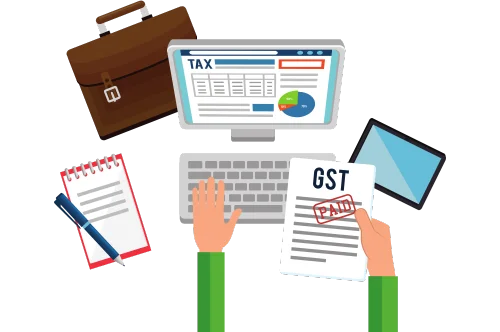The e-commerce industry in India has seen exponential growth, bringing with it significant regulatory and tax compliance requirements. Among these, GST returns filing for e-commerce is one of the most crucial aspects of operating an e-commerce business. For sellers leveraging platforms like Amazon, Flipkart, or Snapdeal, adhering to GST norms ensures legal compliance and avoids penalties.
This step-by-step guide to GST returns filing for e-commerce sellers will help you understand the process and optimize your filings for smooth operations. By following this guide, you can manage your compliance effectively and take advantage of input tax credits (ITC) and TCS deductions to maximize your profitability.
Understanding GST Returns Filing for E-Commerce
GST returns filing for e-commerce involves submitting details of your sales, purchases, and tax collected or paid during a specific period. For e-commerce sellers, this also includes reconciling the Tax Collected at Source (TCS) deducted by platforms. Proper GST returns filing for e-commerce sellers ensures that you remain compliant while claiming refunds or input credits where applicable.
Types of GST Returns Applicable to E-Commerce Sellers
Before diving into the process, it’s essential to know which GST returns apply to e-commerce sellers:
GSTR-1:
- Captures details of outward supplies (sales).
- Must be filed monthly or quarterly, depending on turnover.
GSTR-3B:
- A summary return to declare overall sales, ITC claims, and tax liability.
- Filed monthly.
GSTR-8:
- Filed by e-commerce operators to report TCS deducted from sellers’ payments.
- Sellers must reconcile their records with GSTR-8 to claim TCS credits.
GSTR-9:
- An annual return summarizing all transactions of the financial year.
Step-by-Step Guide to GST Returns Filing for E-Commerce Sellers
Step 1: Register on the GST Portal
Before you can start GST returns filing for e-commerce, ensure your business is registered under GST. For e-commerce sellers, GST registration is mandatory, regardless of turnover.
- Visit the GST portal and complete your registration.
- Ensure you have your GSTIN (Goods and Services Tax Identification Number) ready for filing returns.
Step 2: Maintain Accurate Records
Accurate and organized records are the foundation of successful GST returns filing for e-commerce. For e-commerce sellers, this means:
- Maintaining detailed invoices for every sale.
- Keeping records of business expenses for ITC claims.
- Reconciling sales with the TCS deducted by platforms.
Pro Tip: Use accounting software to automate record-keeping and ensure accuracy in data entry.
Step 3: Gather Required Information
Before filing, collect all necessary information for your GST returns:
- Sales data, including taxable value and GST collected.
- Purchase details for claiming ITC.
- TCS amounts deducted by platforms, as shown in GSTR-8.
This step ensures a seamless GST returns filing for e-commerce process.
Step 4: File GSTR-1 (Outward Supplies)
The first return to file is GSTR-1, where you report details of outward supplies (sales).
- Log in to the GST portal and select GSTR-1 from the dashboard.
- Enter details of sales made during the period, including invoice numbers, taxable value, and GST charged.
- Validate and submit the return.
Frequency: Monthly or quarterly, depending on your turnover.
Step 5: File GSTR-3B (Summary Return)
GSTR-3B is a summary return that consolidates your sales, ITC claims, and tax liability.
- Go to the GSTR-3B section on the GST portal.
- Enter the following details:
- Total sales (taxable and exempt).
- Input tax credit (ITC) claimed.
- Tax liability (adjusted for TCS credits).
- Pay any outstanding GST liability, if applicable.
- Submit the return.
Frequency: Monthly.
Step 6: Reconcile with GSTR-8 (TCS Data)
E-commerce platforms file GSTR-8, which details the TCS deducted on your sales. This is crucial for GST returns filing for e-commerce sellers as you must reconcile this data to claim TCS credits.
- Download GSTR-8 from the GST portal.
- Match the TCS amounts with your sales records.
- Ensure accuracy to avoid discrepancies during filing.
Step 7: Claim Input Tax Credit (ITC)
For e-commerce sellers, claiming ITC is a vital part of maximizing profits. ITC allows you to offset GST paid on business purchases against your tax liability.
- Identify all eligible purchases for ITC (e.g., raw materials, logistics).
- Ensure invoices match the supplier’s GSTR-1 filing.
- Declare ITC claims in GSTR-3B.
Step 8: File GSTR-9 (Annual Return)
At the end of the financial year, e-commerce sellers must file GSTR-9, which provides a summary of all transactions.
- Gather data from GSTR-1, GSTR-3B, and GSTR-8.
- Verify and consolidate all sales, ITC claims, and TCS credits.
- Submit GSTR-9 within the prescribed deadline.
Common Challenges in GST Returns Filing for E-Commerce Sellers
Reconciling TCS Data:
Mismatches between platform reports and your records can delay refunds or lead to notices.Claiming ITC:
Incorrect invoices or unreported purchases may result in denied ITC claims.Late Filing Penalties:
Missing deadlines attracts penalties and interest charges.
Tips to Simplify GST Returns Filing for E-Commerce Sellers
- Automate Compliance: Use GST software to streamline record-keeping and filing.
- Consult an Expert: A tax consultant can help resolve complex issues.
- Stay Updated: GST laws and rules are subject to change. Regular updates ensure compliance.
Conclusion
Filing GST returns is a critical process for e-commerce sellers to ensure compliance and claim tax credits. By following this step-by-step guide to GST returns filing for e-commerce sellers, you can simplify the process and avoid common pitfalls. Regular reconciliation of TCS data, accurate ITC claims, and timely filing will help you manage your GST obligations effectively.
Remember, proper GST returns filing for e-commerce not only keeps you compliant but also improves your cash flow, enabling you to focus on growing your e-commerce business.
Our GST Services For E-commerce Sellers

All E-commerce Tax services
E-commerce tax services help online sellers navigate GST registration, compliance, return filing, TCS management, tax planning, and audits, ensuring efficient tax management and legal compliance.

GST Filing
GST filing is the process of submitting tax returns to the government, detailing sales, purchases, and taxes paid or collected, ensuring compliance with GST laws.

GST Registration
GST registration is the process where businesses obtain a GSTIN from the government, allowing them to collect taxes, claim input tax credits, and comply with GST laws.





